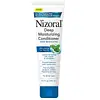What's inside
What's inside
 Key Ingredients
Key Ingredients

 Benefits
Benefits

 Concerns
Concerns

 Ingredients Side-by-side
Ingredients Side-by-side

Water
Skin ConditioningCetearyl Alcohol
EmollientBehentrimonium Chloride
PreservativeCeteareth-20
CleansingCetrimonium Chloride
AntimicrobialCaprylic/Capric Triglyceride
MaskingDimethicone
EmollientGlycerin
HumectantLinoleamidopropyl Pg-Dimonium Chloride Phosphate
Butyrospermum Parkii Butter
Skin ConditioningSimmondsia Chinensis Seed Oil
EmollientPanthenol
Skin ConditioningAllantoin
Skin ConditioningArginine
MaskingPolysorbate 80
EmulsifyingTocopherol
AntioxidantMentha Piperita Oil
MaskingMenthol
MaskingCamellia Sinensis Leaf Extract
AntimicrobialAscorbic Acid
AntioxidantMelaleuca Alternifolia Leaf Oil
AntioxidantXanthan Gum
EmulsifyingPhenoxyethanol
PreservativeDisodium EDTA
Potassium Sorbate
PreservativeCitric Acid
BufferingWater, Cetearyl Alcohol, Behentrimonium Chloride, Ceteareth-20, Cetrimonium Chloride, Caprylic/Capric Triglyceride, Dimethicone, Glycerin, Linoleamidopropyl Pg-Dimonium Chloride Phosphate, Butyrospermum Parkii Butter, Simmondsia Chinensis Seed Oil, Panthenol, Allantoin, Arginine, Polysorbate 80, Tocopherol, Mentha Piperita Oil, Menthol, Camellia Sinensis Leaf Extract, Ascorbic Acid, Melaleuca Alternifolia Leaf Oil, Xanthan Gum, Phenoxyethanol, Disodium EDTA, Potassium Sorbate, Citric Acid
Water
Skin ConditioningAloe Barbadensis Leaf Juice
Skin ConditioningBrassica Alcohol
EmollientGlycerin
HumectantCocos Nucifera Oil
MaskingCapryloyl Glycerin/Sebacic Acid Copolymer
Skin ConditioningDiheptyl Succinate
EmollientBrassicyl Isoleucinate Esylate
Emulsion StabilisingCitrus Aurantium Dulcis Peel Oil
MaskingEucalyptus Globulus Leaf Oil
PerfumingMelaleuca Alternifolia Leaf Oil
AntioxidantMentha Arvensis Leaf Oil
MaskingMentha Piperita Oil
MaskingRosmarinus Officinalis Leaf Oil
MaskingCalendula Officinalis Flower Extract
MaskingChamomilla Recutita Flower Extract
MaskingChenopodium Quinoa Seed
AbrasiveTocopheryl Acetate
AntioxidantAlcohol
AntimicrobialArachidyl Alcohol
EmollientArginine
MaskingBehenyl Alcohol
EmollientCalcium Gluconate
HumectantGlyceryl Stearate
EmollientStearyl Alcohol
EmollientGluconolactone
Skin ConditioningSodium Benzoate
MaskingLimonene
PerfumingLinalool
PerfumingWater, Aloe Barbadensis Leaf Juice, Brassica Alcohol, Glycerin, Cocos Nucifera Oil, Capryloyl Glycerin/Sebacic Acid Copolymer, Diheptyl Succinate, Brassicyl Isoleucinate Esylate, Citrus Aurantium Dulcis Peel Oil, Eucalyptus Globulus Leaf Oil, Melaleuca Alternifolia Leaf Oil, Mentha Arvensis Leaf Oil, Mentha Piperita Oil, Rosmarinus Officinalis Leaf Oil, Calendula Officinalis Flower Extract, Chamomilla Recutita Flower Extract, Chenopodium Quinoa Seed, Tocopheryl Acetate, Alcohol, Arachidyl Alcohol, Arginine, Behenyl Alcohol, Calcium Gluconate, Glyceryl Stearate, Stearyl Alcohol, Gluconolactone, Sodium Benzoate, Limonene, Linalool
Ingredients Explained
These ingredients are found in both products.
Ingredients higher up in an ingredient list are typically present in a larger amount.
Arginine is an amino acid that is important for human development. Your body uses is it to produce hair keratin and skin collagen.
As a cosmetic ingredient, Arginine has antioxidant properties and can also help repair damaged skin. This ingredient is derived either synthetically or from animals.
Arginine isn't fungal acne safe when used in the presence of other lipids (fats, fatty acids, oils, esters, etc). Oils and fats occur naturally within the skin, so take caution when using Arginine if you're prone to fungal acne.
Learn more about ArginineGlycerin is already naturally found in your skin. It helps moisturize and protect your skin.
A study from 2016 found glycerin to be more effective as a humectant than AHAs and hyaluronic acid.
As a humectant, it helps the skin stay hydrated by pulling moisture to your skin. The low molecular weight of glycerin allows it to pull moisture into the deeper layers of your skin.
Hydrated skin improves your skin barrier; Your skin barrier helps protect against irritants and bacteria.
Glycerin has also been found to have antimicrobial and antiviral properties. Due to these properties, glycerin is often used in wound and burn treatments.
In cosmetics, glycerin is usually derived from plants such as soybean or palm. However, it can also be sourced from animals, such as tallow or animal fat.
This ingredient is organic, colorless, odorless, and non-toxic.
Glycerin is the name for this ingredient in American English. British English uses Glycerol/Glycerine.
Learn more about GlycerinThis tea tree oil comes from the leaves of the Tea Tree plant. Tea tree oil has antioxidant, anti-inflammatory, and antimicrobial properties.
According to the book Journal of Profiles of Drug Substances, tea tree helps in reducing acne-causing bacteria such as Propionibacterium acnes. This is due to the Terpinen components of tea tree oil.
Tea tree may cause sensitivity and irritation for some people. This oil naturally contains fragrance such as linalool and limonene.
However, research shows irritation usually occurs when using pure tea tree oil and not in cosmetic products.
Tea tree oil was found to help relieve the symptoms of psoriasis in one study.
Tea tree oil is toxic when ingested. Another study showed it to caused damage to the nervous system of dogs and cats when applied to their skin or given orally.
Learn more about Melaleuca Alternifolia Leaf OilMentha Piperita Oil is the volatile oil obtained from the whole plant of the Peppermint plant.
It can be used to add a fresh scent to products.
Peppermint oil may cause skin sensitivity and redness due to its menthol content. Menthol also has a cooling effect (like your toothpaste).
Learn more about Mentha Piperita OilWater. It's the most common cosmetic ingredient of all. You'll usually see it at the top of ingredient lists, meaning that it makes up the largest part of the product.
So why is it so popular? Water most often acts as a solvent - this means that it helps dissolve other ingredients into the formulation.
You'll also recognize water as that liquid we all need to stay alive. If you see this, drink a glass of water. Stay hydrated!
Learn more about Water